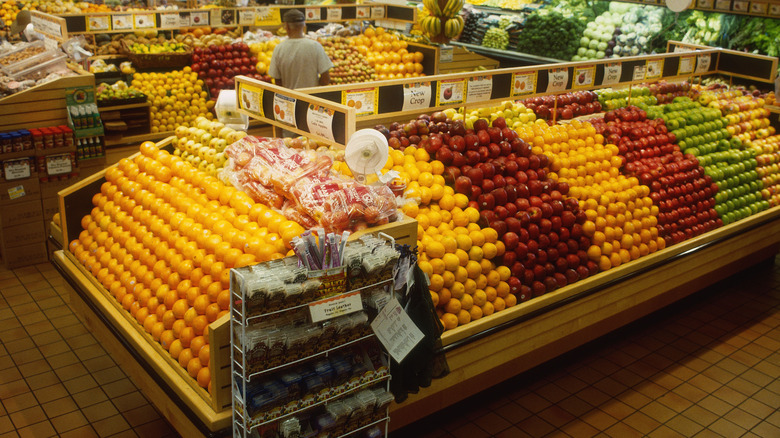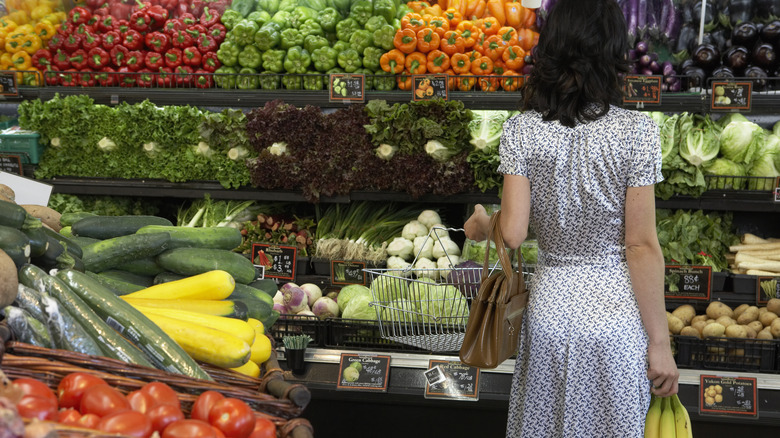You'll Have To Dig A Bit To Find The Freshest Produce At The Grocery Store
You're in the produce aisle of your local grocery store, looking to stock up on fruit and vegetables for the week. When you walk down the aisle, however, you can't help but feel disappointed. The lettuce heads, wet and cold from the automatic sprayer system, seem almost wilted and brown around the edges. The carrots seem blotted with brown stains, the celery seems dull and flimsy rather than green and vibrant, and the tomatoes seem bruised and dirty. Even the fruit, from the strawberries in their plastic boxes to the bananas in their cardboard boxes, all seem to be in the early stages of rotting.
If this has ever happened to you, you're not alone. While many grocery stores do their best to stock produce aisles with fresh and healthy items, it's an unfortunate fact that you may sometimes come across produce that seems more suitable for compost than on display. Whether it's chefs on Reddit discussing how they found near-expired spinach or slimy green beans, or Forbes' claims that old, unused produce winds up in the pre-made salads you'll find at the nearby deli, the grocery store produce aisle isn't always rosy red apples or juicy tomatoes.
But this doesn't necessarily mean you can't find fresh produce in your grocery store. If you want to find the freshest carton of berries or the greenest stalks of lettuce, you're going to have to do a little bit of digging — literally.
The freshest produce is in the back
When you walk down the produce aisle, you probably grab the first item you want in order of how it's placed on the shelf. If you want a carton of blueberries, for example, you'd most likely grab the first carton on the shelf rather than paw through and grab the second or third one. While this is a reflex that's ingrained into most people, it may be beneficial to do a little bit of digging to get the freshest produce in the back.
Nutritionist Nicolette Pace explains to Reader's Digest that, by way of how produce is stocked in grocery stores, produce that has the newest or longest expiration date are found closer to the back of the shelf than in the front. This is because produce that has a shorter shelf life is set out first, making it more likely that a customer will purchase it and use it before the expiration date.
While a sound idea, the problem is if no customer purchases said produce before the end of its already short shelf life, that produce will go bad. By looking in the back, you're more likely to find produce that's still fresh — or at least fresher than the produce placed in front. While selecting from the back means that you're more likely to get a fresher product, it'll also be "cleaner" too.
Produce from the back is less likely to be touched
If you were to hang out in your grocery produce aisle, you may notice a rather odd scene every so often: someone will come by, grab a head of lettuce or a piece of fruit, inspect it, and then put it right back down again without even cleaning it off. That means that whoever buys that particular piece of produce will be taking home all the possible germs that previous person left behind.
One of the benefits of getting your produce from the back of the shelf is that there's a far less likely chance that someone was touching it. While the items up front may have been picked up and handled by anyone, the produce in the back was at least handled by someone wearing gloves and only moved to be on the shelf rather than picked up and down. Indeed, it's not too far-fetched to be worried about who exactly was handling your produce before you. A study performed by Reuse This Bag revealed that your average grocery store produce has over 746 times more bacteria than the average steering wheel of a car.
While this may seem like a terrifying statistic at first, it's important to remember that, so long as you thoroughly wash your produce when you get home, you should have absolutely no problems at all when eating any kind of fruit or vegetable you got at the store, front or back.


